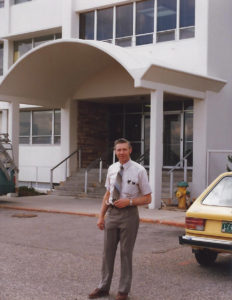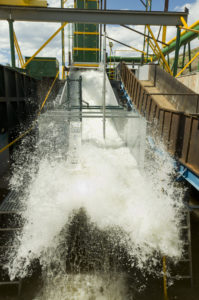The Hydromachinery Building at the Engineering Research Center (ERC) was built in the early 1960s with a budget of just $25,000. The person responsible for its construction was Emeritus Professor Jim Ruff, also an electrical engineering and civil engineering graduate of Colorado State University.

As an early mainstay of the Hydraulics Program, Ruff has demonstrated his dedication to the program’s continued success by providing new support for future investments in the form of updated technology and infrastructure.
Getting the water engineering technology updated at CSU is a big step for the Hydraulics Program. Thanks to Ruff’s gift, the program will be getting a particle imagery velocity system, which maps surface velocity of water and allows for better visualization capabilities for physical modeling. The lab will also be installing a sonic flow meter and updating an existing flume.
“We built the Hydromachinery Building in three weeks, and hired every concrete truck in town to do it. As the concrete was being poured, a large crowd collected on the hill north of the ERC to see what was going on – they were afraid the dam broke,” Ruff said.
Though the Hydromachinery Building is no longer used, it represents a landmark event in CSU’s history. Because of its location, the university was in a unique position to run hydraulics experiments in a way no other research entity could.
“No one else had a reservoir and access to a tremendous amount of water like we did. We could generate a lot of research with those resources,” Ruff said.
And, under the supervision of some of CSU’s greatest professors, including Maury Albertson, Darryl Simons, and Ev Richardson, the university’s Hydraulics Program continued to gain momentum. As dams were being built around the world, the Hydraulics Program at CSU was consulted to help with design. The resources available at the ERC enabled researchers to do lab testing on key parts of dams, especially spillways. The world’s largest earthfill dam, Pakistan’s Tarbela Dam, is just one of many examples of this type of work.
Future of the hydraulics program
Today, the Hydraulics Program continues, but the technology and infrastructure needed to run experiments look a bit different. While physical modeling is still the foundation of hydraulic research, effective problem solving benefits from the use of advanced computers and programs for handling large amounts of experimental data and numerical simulation.

Ruff’s history with the Hydraulics Program and the Department of Civil and Environmental Engineering has inspired CSU’s current faculty to drive an ambitious vision forward, and his recent investment in the program has served as the catalyst for this campaign.
Professors Christopher Thornton, Robert Ettema and Pierre Julien, senior faculty of CSU’s Laboratory for Water Engineering and Science, seek to position the program as a leading, university-based hub for water engineering and science. The lab is already an integral part of CSU’s water programs with national and international recognition, and the faculty aim to expand the trans-disciplinary nature of the program, as well as take advantage of cutting-edge technology needed to address water challenges.
New technology for water challenges
Recent technology represents changes in the capabilities of hydraulics and water engineering research. “Sixty years ago, we had very simple instrumentation. Now we can measure turbulence, the transport of sediment, heat and contaminants by flows, actually see what flows are doing, and we have the ability to numerically model these flows, all thanks for computers,” Ettema said.
 The Hydraulics Program is well positioned to address water challenges arising from food, energy, health, climate change process, poverty and security, and the sustainability of natural and built environments. Thornton and Ettema are confident CSU can handle the challenges. As Thornton notes, “We have a long history that gives our program credibility to move forward, more so than any other program in the country. If we can’t do it here, other institutions may not be as adept at doing it, either.”
The Hydraulics Program is well positioned to address water challenges arising from food, energy, health, climate change process, poverty and security, and the sustainability of natural and built environments. Thornton and Ettema are confident CSU can handle the challenges. As Thornton notes, “We have a long history that gives our program credibility to move forward, more so than any other program in the country. If we can’t do it here, other institutions may not be as adept at doing it, either.”
Get more information or give a gift to support the Hydraulics Laboratory at CSU.